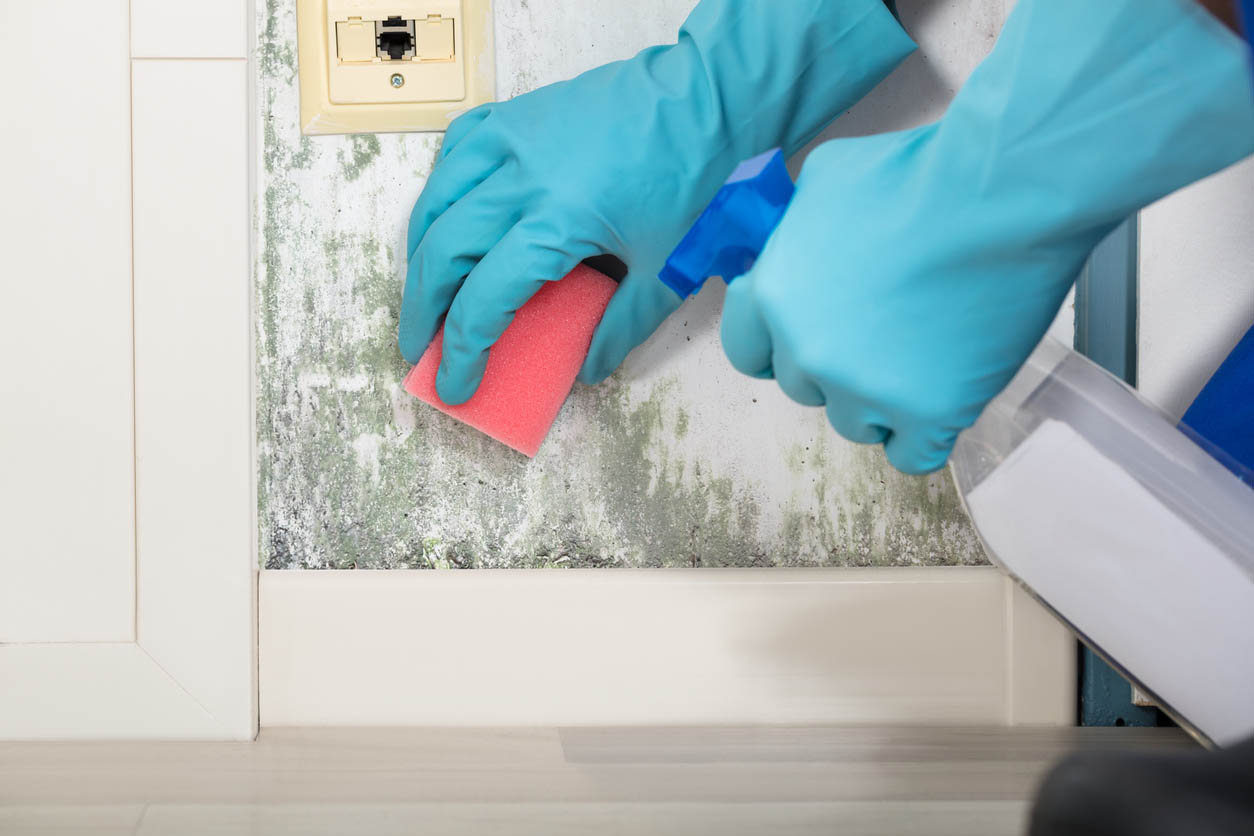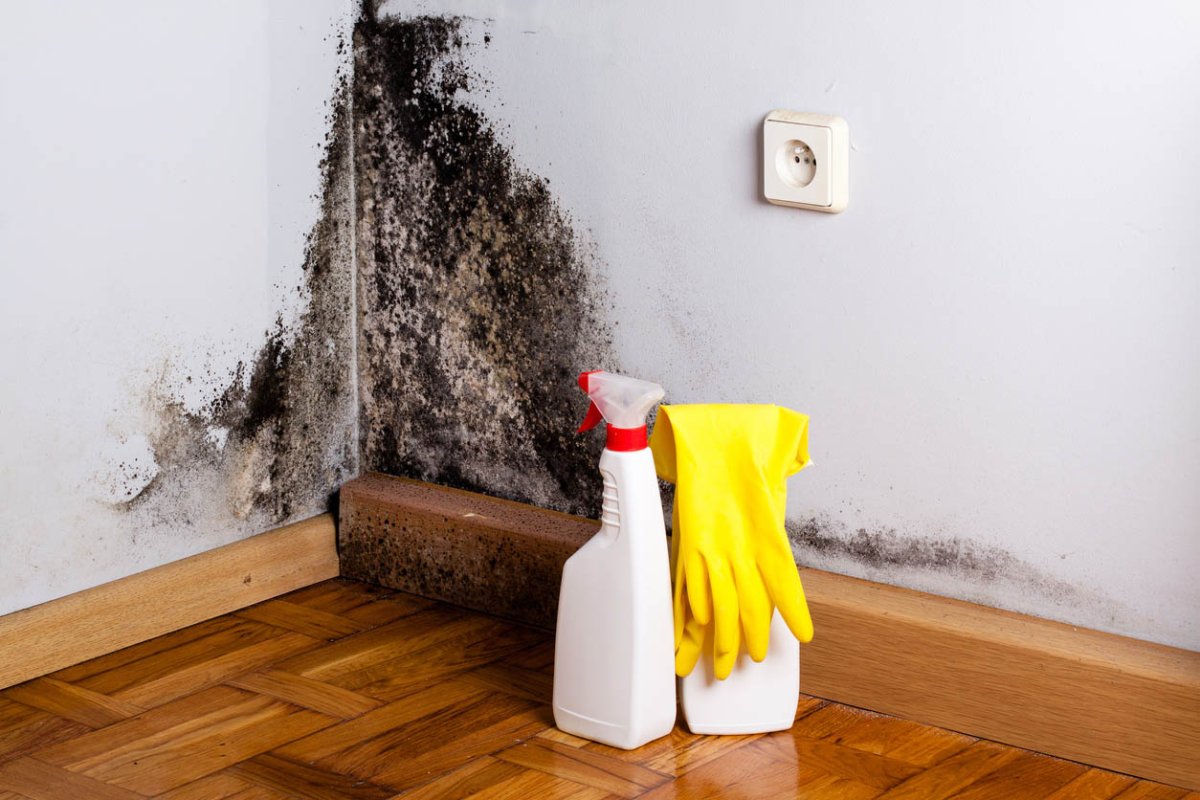We may earn revenue from the products available on this page and participate in affiliate programs. Learn More ›
What You Need to Know
- Bleach can kill surface mold but won’t remove it entirely.
- Vinegar can kill mold by penetrating it to its roots.
- Other options include hydrogen peroxide, baking soda, essential oils, and lemon.
- For larger mold infestations, homeowners will want to hire a professional mold remediation company.
Q: I think I’ve found mold in my home. What’s the best product to kill mold once it’s identified?
A: When a homeowner positively identifies mold in their home, it’s essential to take care of it as soon as possible, so the mold spores don’t spread. Mold can cause several underlying health conditions and cause wooden surfaces to rot if left unchecked. Mold loves moist areas such as basements, kitchens, and bathrooms. Under the right conditions, black mold can grow in just 24 to 48 hours.
There are multiple, safe ingredients used to kill mold simply found around the house. Here’s what kills mold and stops the spread within the home.
1. Bleach kills surface mold but not the underlying membrane.
Bleach is a household staple for its ability to disinfect and thoroughly clean most surfaces. Bleach can kill mold that lives on the surface; however, the chemical structure of bleach makes it impossible to reach porous surfaces where the membrane of the mold lives. This means the mold will grow back even after the surface has been cleared.
Additionally, bleach can also be a food source for certain mold types once it’s introduced and can cause the mold to spread, burrowing deeper into an area so the bleach can’t reach it. For this reason, it’s recommended to only use bleach to clean small amounts of mold growing only on non-porous surfaces.
To kill mold using bleach, use a solution with a ratio of one part bleach to 10 parts water. Ensure you’re in a well-ventilated area, as bleach is an abrasive chemical that emits harsh fumes. Apply the solution to the mold with either a spray bottle or a sponge and bucket. The surface doesn’t need to be rinsed after application unless it’s in a food preparation area.
2. Vinegar penetrates porous materials and kills mold at the roots.
Vinegar is a strong substitute for bleach and other harsh chemicals when it comes to killing mold. The acidity of the vinegar can penetrate porous materials and eliminate the membrane of mold below most surfaces. Use regular, distilled white vinegar to kill mold, as it’s the most acidic. Some homeowners can even utilize vinegar directly to their walls or linoleum floors as a cleaning technique to prevent mold from forming.
To kill mold using vinegar, add the distilled white vinegar directly to a spray bottle without diluting it. Spray the affected area with the vinegar and let it sit for an hour to allow the vinegar to penetrate the surface and kill the mold at the root. Rinse the surface with warm water, spray again with vinegar, and allow to dry.
3. Hydrogen peroxide can remove mold.
Hydrogen peroxide is an antifungal, antiviral, and antibacterial solution used to prevent infection in wounds, so it’s found in most home medicine cabinets. However, it’s also a powerful mold killer, especially with solutions that have more than 3 percent of hydrogen peroxide concentration.
Hydrogen peroxide is best used on porous and non-porous surfaces, including clothing, bathroom items, and even kitchen appliances. However, as it’s a bleaching agent, ensure to spot test the area before cleaning to ensure the material won’t fade.
To kill mold using hydrogen peroxide, place undiluted 3 percent hydrogen peroxide solution into a spray bottle. Saturate the moldy area with the solution using the spray bottle and allow it to sit for 10 minutes. During this process, the hydrogen peroxide will kill the mold. Scrub the area with an abrasive sponge to ensure the entire area is clear of mold and allow the hydrogen peroxide to fade the mold stain. Finish by using a clean towel to dry the area.

4. Baking soda mixed in water will remove mold.
Baking soda, also known as sodium bicarbonate, is a more natural way of killing mold. It’s found in most households and is a natural cleanser that’s harmless to children and pets. Baking soda is also a deodorizer, meaning it can help clear the smell of mold as well as the mold itself. Baking soda is commonly used alongside vinegar to clean up mold as they both can kill different types of mold.
To kill mold using baking soda, place 1 teaspoon of baking soda with 2 cups water in a spray bottle and shake well to incorporate. Spray the mold with the solution and use a scrubbing brush or sponge to remove the mold. Rinse the surface with water and finish with another layer of the baking soda solution and let dry.
5. Essential oils and lemon are natural deodorizers and antiseptics that kill mold on every surface.
While essential oils are a popular wellness product, they also can tackle black mold. Tea tree oil specifically is an insect repellant, natural deodorizer, and antiseptic used in everything from deodorants to common household cleaners. Using tea tree oil to kill black mold is one of the safest options. To kill mold using tea tree oil, combine one tablespoon of the oil with one cup of water and shake. Spray the moldy area with the solution and let it sit for one hour to penetrate the mold roots. Finally, use a cloth to wipe any excess mold away. Use caution if you have pets, as essential oils can be harmful if ingested or aerosolized.
Lemons are another form of natural mold removal due to their high acidity. They can be used as a bleaching agent, a deodorizer, a cleanser, and an antiseptic, making them powerful mold-killers. To kill mold using lemons, juice three to five lemons and pour over the mold. Allow to sit for 5 minutes before wiping clean.
If you’re not willing to take a chance, call for professional assistance in killing mold.
The above methods can tackle most small mold issues. However, if there are multiple mold spots on the walls or a large area covered with mold, it’s best to contact a professional to ensure the mold is taken care of correctly and efficiently.

